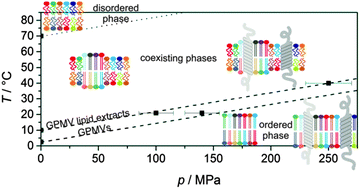Exploring the structure and phase behavior of plasma membrane vesicles under extreme environmental conditions†
Abstract
Not only drastic temperature- but also pressure-induced perturbations of membrane organization pose a serious challenge to the biological cell. Although high hydrostatic pressure significantly influences the structural properties and thus functional characteristics of cells, this has not prevented life from invading the high pressure habitats of marine depths where pressures up to the 100 MPa level are encountered. Here, the temperature- and pressure-dependent structure and phase behavior of giant plasma membrane vesicles have been explored in the absence and presence of membrane proteins using a combined spectroscopic and microscopic approach. Demixing into extended liquid-ordered and liquid-disordered domains is observed over a wide range of temperatures and pressures. Only at pressures beyond 200 MPa a physiologically unfavorable all gel-like ordered lipid phase is reached at ambient temperature. This is in fact the pressure range where the membrane–protein function has generally been observed to cease, thereby shedding new light on the possible origin of this observation.


 Please wait while we load your content...
Please wait while we load your content...